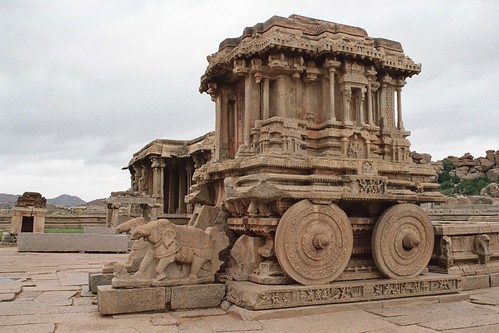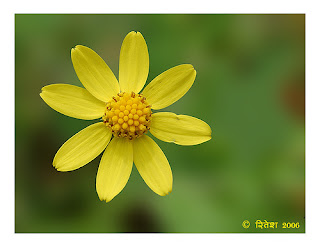Pallava temple architecture :
The Pallava dynasty ruled from AD 600 to 900. The characteristic feature of the Pallava temple architecture is the rock-cut temples. The finest specimen of rock-cut shrines can be seen at Mahabalipuram. The Shore temple at Mahabalipuram is a fully carved temple complex with a towered sanctuary and mandapa.

The Shore Temple was the first Pallava structure to be built of stone rather than being hewn out of stone like the older temples. The greatest improvement in design is in the shikhara or spire, which has altered from the rounded vihara design to a soaring, tiered style. Elements like the vimana or spire, the gopuram or gateway and animal figures that were to become trademark features of Dravidian architecture can all be seen here. And it is largely the use of dressed stone, which gave the architects greater creative freedom.
The main shrine faces the sea on the east and the gateway, the forecourt and the assembly hall of the Shore Temple lie behind the sanctum. The temple has shrines to both Lord Shiva and Lord Vishnu. The main sanctum and one of the two lesser ones on the west are dedicated to the Shiva. The enclosing wall has a series of Nandi bulls on it. Interconnected cisterns around the temple meant that the sea could be let in to transform the temple into a water shrine. A stone wall as been added to protect the shrine from the rising seas and further erosion in the recent times.

---------
Chola temple architecture:
The Chola dynasty ruled from AD 900-1150. The zenith of the Chola temple architecture can be seen at Thanjavur. It was the capital established by the Chola ruler Rajaraja I. The shrines have rising pyramidal towers crowned with domical roofs. The walls are embellished by the sculptures and paintings. The Bronze sculptures of this period are one ofthe finest in the whole of the South India.

The Brihadeswara temple at Thanjaur is within a huge compound with walls rising above 15m. The temple is made over a 29 m square base and has a soaring vimana and a stunted gopuram. The inner sanctum and the gopuram were constructed over a period of 12 years. It was constructed from a single piece of granite weighing around 80 tones. The dome was hauled into place along a 4-km earthwork ramp in a manner similar to the Egyptian pyramids.
The lofty sanctum tower known as the Srivimana, is enclosed by a rectangular prakara or corridor consisting of two squares. The inner wall of the garbhagriha or the sanctum sanctorum has sculpted 108 dance poses called karmas performed by Lord Shiva himself. The Shiva lingam is called Peruvudaiya, Rasjarajeshwaramudvya. It is a huge lingam, which is set in a two-storeyed sanctum. Rajaraja Chola crowned it with 12.5 ft tall finial of 9.25 kilograms of choppers plated with 800 grams of gold.
A huge statue of Nandi measuring 6 m length and 3.7 m in height faces the inner sanctum. The statue of Nandi was created from a single rock piece and weighs 25 tones. It is in fact one of the largest statues of Nandi bulls in India. The temple also has a spacious ground, number of pillared halls, shrines and 250 lingams.
--------------
The period of the reign of Hoysalas is from AD 1100-1350. The temples erected by the Hoysala kings have complex plans with numerous angled projections. The Chlorite stone was carved on the surface with remarkable precision. The columns of the temples are multi-faceted. The example of the Hoysala temples can still be seen at Belur, Halebid and Sringeri. The temple building activity came to an abrupt end due to the Muslim invasion.
The Hoysaleshwara temple at Halebid stands on a platform like a casket. The temple is dedicated to Lord Shiva. It has two shrines connected by the pillared walls. Each of the shrine has the lingam of Hoysaleshwara and Shanthaleshwara. Ketumalla who was the chief of the staff of Vishnuvardhan built the temple in 1121 AD.
The temple is richly ornamented with most intricately detailed scrollwork in stone. Outside there is figure of Nandi or the Bull, the mount of Shiva outside the shrine over a hillock. The figure of mortals and immortals are larger here in comparison to Belur. They are beautifully chiseled in shining black stone. The walls of the temples are embellished with variety of sculptures of the gods and goddesses, animals, birds and dancing girls.


---------------
The construction of temples gained fervor once again during the period of the Vijayanagara Empire. The characteristic feature of the temples of this period the growth of the temple complexes. The temples are concentric sequence of rectangular enclosure walls having gopuras in the center. The best examples of the temples of Vijaynagara are at Hampi.
![[IMG_9654.JPG]](https://blogger.googleusercontent.com/img/b/R29vZ2xl/AVvXsEjAbWjfv7PkS2jnc2IK-VXEpjXkwrk87vuTgA1z4MZ1XSTYW9QfmzENskUjQy1Pf3-zbSIeJBsh-itqcpjzwLyTBymBW-ZmZKy7gYUn9WmnjzPTEzeKR_TNWykqEIoo_kzMEntpQgPhjpM4/s1600/IMG_9654.JPG)
A pillared colonnade is surrounded all along the interior of the enclosing wall. The main shrine is in the center of the enclosed courtyard along with mandapa, amman sanctum, the kalyana mandapa, an utsava mandapa, a hundred-pillared mandapa and a stone ratha. There was a originally a lofty kipa-stambha, measuring 12.2 m in height, in front of the east gopuram. But now it is broken condition and lies on the ground. The main shrine was dedicated to Vishnu in the form of Vithala.

![[IMG_9640.JPG]](https://blogger.googleusercontent.com/img/b/R29vZ2xl/AVvXsEhEmLSFDGnRAM2y66dZabi4iXDBPNxSCDckwvmogH3z4CFNTotyxQdeKXXVicMWXIrdmr4Q4WhHHB1k1ifgDV9ub979p2jGsil3_nDMdCkQcdOaMAj-dbd2hArODyZFHwVRcGrfgVPAHa1S/s1600/IMG_9640.JPG)





























